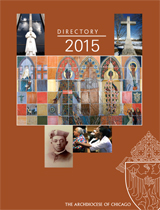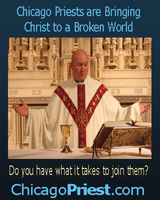July 20, 2008
Church responds as violence spikes
It started in April, when headlines screamed “36 shootings, 9 homicides” over the course of one weekend. Since then, the violence has continued, with news of shootings nearly every day.
The violence has touched the Catholic community, with Catholic school students and adult Catholics among the victims, and violence occurring near and sometimes even on church property.
On June 30, a 15-year-old student at St. Francis de Sales High School was shot and wounded while he was walking home with several friends near 131st Street and Rhodes Avenue. An 11-yearold girl who was part of the group also was shot. Police said they don’t think either young person was the intended target of the shooting,
On July 1, another 15-year-old was shot in the basement of St. Margaret of Scotland Parish’s rectory — apparently the victim of an armed robbery. Two other teens, with whom he was playing dice, have been charged in the crime.
On July 2, Chicago Police Office Richard Francis was killed during a disturbance when an assailant shot him with his own gun at Belmont and Western Avenues, across the street from the Area 3 police headquarters. A 45-year-old woman, who was shot several times by officers who responded to the scene, was charged with killing him.
Officer Francis was laid to rest after a two-hour funeral service at St. Monica Church on the Northwest Side July 7. The 60-year-old, 27-year veteran was eulogized by his step-daughter as “the best darn police officer I ever knew,” a man who loved his family and his work.
Parishes respond
In response to the violence, parishes have sponsored anti-violence marches, including one June 12 at St. Agatha Parish in North Lawndale; offered opportunities for young people to get off the streets and into activities, such as playing basketball in the gym at St. Michael Parish in Back-of-the- Yards; and helped people find employment by holding job-training and mentoring programs.
The church is called to respond to violence by praying, but it has to do more than that, said Nicholas Lund- Molfese, the director of the the archdiocese’s Office for Peace and Justice, just as it must do something to feed people who are hungry, in addition to praying for them.
To that end, the office recently hired Meghan Mayo, a graduate student in social justice at Loyola University of Chicago, to help parishes find ways to respond to and prevent violence. Mayo, who started about two months ago, said she is gathering resources and ideas, so that she can offer real assistance to parishes.
“I don’t want to just give them a list of things that they’ve already tried and didn’t work,” she said.
Her efforts are in concert with the teachings of the U.S. Catholic Bishops, who wrote:
“The Catholic community is in a position to respond to violence and the threat of violence in our society with new commitment and creativity. More of the same is not sufficient.
“Business as usual is not enough. Our faith and facilities can be beacons of hope and safety for those seeking refuge from violent streets and abusive homes. People can become peacemakers in their homes and communities. Parishes can organize mentoring programs for teen parents. The Church can be the first point of referral for spousal abuse.
“We can incorporate ways to handle family conflict in our religious education and sacramental preparation programs. We can work for public policies that confront violence, build community and promote responsibility. Finally, we can join with other churches in developing a community wide strategy for making our neighborhoods more safe, welcoming and peaceful.” (Confronting a Culture of Violence: A Catholic Framework for Action, USCCB, 1994)
Chicago Police Superintendent Jody Weis used the July 12 march at St. Agatha to release Chicago crime statistics for June 2008. Weis was under political pressure because of the rising crime rate, including shootings following the July 3 fireworks, after coming into the department and cleaning house among the command ranks of the department.
The statistics showed crime held steady in June, compared to the first five months of the year. Overall, murders were up almost 13 percent from 2007. About 40 percent of the murders were classified as gang-related, and in most of the rest, the victims knew their attackers, he said. Nearly 90 percent of the people charged in homicide cases had prior criminal records; so did more than 70 percent of the victims.
That was not the case for Officer Francis, a liked and respected officer whose catchphrase was “Isn’t life great?”
Father Thomas Nangle, chaplain to the Chicago Police Department, was the main celebrant and homilist at the officer’s funeral Mass. Speaking to a church packed mostly with police officers, in addition to Francis’ family, Illinois Gov. Rod Blagojevich and Mayor Richard M. Daley, Nangle spoke of the role the police play in society, comparing it to the position of the Roman centurion who, in Mark’s Gospel, was the first to look up at the crucified body of Christ and say, “Truly, this was the Son of God.” The centurion, Nangle noted, was likely part of the company that did the actual crucifixion.
“The centurions were involved in the everyday mix and mess of life in the Holy Land,” Nangle said, as modern police are.
Nangle told the congregation — which included hundreds of officers in the parking lot who could not fit into the church — that Francis did not “give” his life in the line of duty. “He did not give his life,” Nangle said. “It was taken from him.”
It was taken while Francis was doing a necessary and important job, the same job the officers at the funeral do every day.
“You are the barbed wire that separate the sheep from the wolves,” Nangle said.
 Catholic
New World - Newspaper for the Archdiocese of Chicago
Catholic
New World - Newspaper for the Archdiocese of Chicago Archdiocese of Chicago Directory
Archdiocese of Chicago Directory Oficjalne wydawnictwo Archidiecezji Chicago w języku polskim
Oficjalne wydawnictwo Archidiecezji Chicago w języku polskim